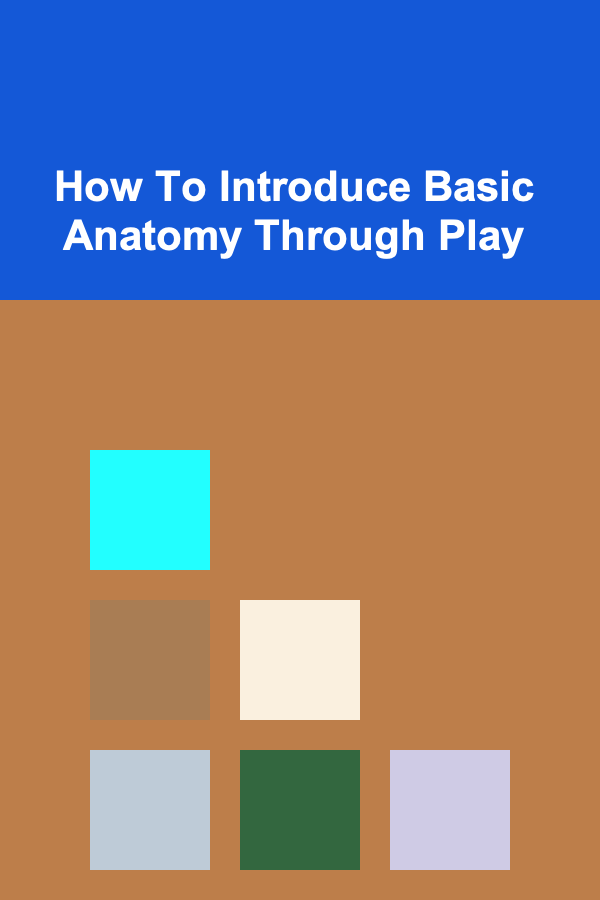
How To Introduce Basic Anatomy Through Play
ebook include PDF & Audio bundle (Micro Guide)
$12.99$7.99
Limited Time Offer! Order within the next:

Understanding human anatomy is a fundamental part of education that opens up opportunities for critical thinking, scientific inquiry, and a deeper appreciation of the human body. However, traditional methods of teaching anatomy can be intimidating, particularly for young children or beginners. One of the most effective ways to introduce basic anatomy concepts is through play. Play is a natural, engaging way for individuals, especially children, to explore complex ideas, build understanding, and make connections with the world around them. In this article, we will explore how basic anatomy can be introduced through play, providing insights and practical strategies for educators, parents, and caregivers.
The Power of Play in Learning
Play is not just an enjoyable activity---it is an essential part of childhood development. According to Jean Piaget, a renowned developmental psychologist, play helps children move from concrete to abstract thinking. Through play, children learn to problem-solve, develop fine and gross motor skills, and practice social interaction and communication. When it comes to learning concepts like human anatomy, play provides an immersive, hands-on approach that reinforces learning and retention.
Additionally, play helps create a non-threatening and engaging environment that lowers the anxiety often associated with academic subjects. For young children especially, making anatomy fun and interactive transforms what could be a dry or overwhelming subject into a captivating experience.
How Play Aids Anatomy Learning
-
Engagement Through Interactive Learning
Play-based learning invites children to participate actively, rather than passively receiving information. This hands-on engagement with anatomy---such as touching, moving, and creating---supports deeper comprehension. For example, rather than simply memorizing the names of body parts, children can physically manipulate body models, engage in creative role-play, or even explore virtual simulations to better understand the structure and function of various organs and systems.
-
Encouragement of Curiosity
Children are naturally curious. Play allows them to explore topics that pique their interest and answer the many questions that arise. By integrating anatomy into playful activities, educators can nurture curiosity, creating an environment where children feel empowered to ask questions, experiment, and seek answers. This intrinsic motivation promotes self-directed learning, where children actively shape their own understanding of anatomy through experimentation.
-
Multisensory Learning
Anatomy is a complex field that involves understanding shapes, functions, and relationships between different body parts. Play-based learning often involves multiple senses, from seeing and hearing to touching and manipulating objects. This multisensory approach helps children build more comprehensive and lasting mental maps of anatomical structures. For example, playing with a model of the human body allows children to physically touch and explore organs, fostering a deeper understanding of how different parts work together.
Strategies to Introduce Basic Anatomy Through Play
The key to using play effectively in teaching anatomy is to create activities that are fun, educational, and age-appropriate. The following strategies provide ways to integrate basic anatomy concepts into engaging play experiences.
1. Building Anatomy Models
Creating or using existing models of the human body can make learning anatomy interactive and visually stimulating. These models can vary in complexity, from simple human skeletons to full-body models with removable organs. By letting children build and manipulate these models, they get hands-on experience with the structure of the human body. This can be done with:
- Puzzle Models: Simple puzzles that fit together to form a human body or organ systems allow children to visualize and understand spatial relationships between different anatomical structures.
- 3D Printed Models: For older children or those who enjoy more advanced activities, 3D printing technology can create detailed, customizable anatomical models. Students can print parts of the body, like bones, organs, or muscles, and assemble them for interactive learning.
2. Role-Playing Activities
Role-playing is an excellent way for children to understand anatomy in the context of real-world applications. Through role-playing, children can assume the roles of doctors, nurses, or even patients. These activities can help them understand how different parts of the body function together to maintain health. For example:
- Doctor and Patient Play: Children can take turns playing the roles of doctors and patients, using anatomical models or drawings to diagnose and treat "patients." This scenario encourages them to talk about the different organs, systems, and how the body works together.
- Healthy Habits Role Play: Role-playing different scenarios related to maintaining health (such as eating healthy foods, exercising, or washing hands) helps children understand how actions affect the body. This approach makes the anatomy lesson relevant to daily life.
3. Creative Art Projects
Artistic expression can be an ideal medium for teaching anatomy. Allowing children to draw, paint, or craft representations of the human body provides them with a chance to internalize anatomical knowledge while tapping into their creativity. Some activities include:
- Drawing Body Parts: Provide children with templates or encourage them to create their own illustrations of the human body. They can label the different body parts, add details about the functions of each system, and color the organs accordingly.
- Modeling with Clay or Playdough: Children can use clay or playdough to shape various body parts, like muscles, bones, or organs. This hands-on creation gives them a tactile understanding of anatomical structures and how they fit together.
- Collage and Mixed Media: Use materials like fabric, paper, or natural items to create collages that represent organs or body systems. This method engages students in exploring the body's parts visually while fostering creativity and critical thinking.
4. Games and Puzzles
Games and puzzles are timeless tools that can make learning fun. Incorporating anatomy into games offers an engaging way to reinforce knowledge and skills. Here are some suggestions for incorporating anatomy into play through games:
- Body Part Bingo: Create bingo cards with different anatomical structures, and call out the names of body parts for children to mark on their cards. This activity reinforces vocabulary and helps students familiarize themselves with the names and locations of various body parts.
- Anatomy Memory Match: Using pairs of cards, one side displaying the name of a body part and the other showing a picture of that part, children can play a memory matching game. This improves their recall and reinforces connections between names and images of anatomical structures.
- Human Body Scavenger Hunt: Hide model body parts or organ representations around the room and challenge children to find and identify them. This activity combines physical activity with learning and helps children reinforce their understanding of anatomy.
5. Interactive Technology
Incorporating technology into anatomy lessons can greatly enhance the learning experience. Technology offers immersive, interactive tools that can simulate the human body in ways that are difficult with traditional materials. Some options include:
- Virtual Anatomy Apps: There are many apps and online tools that offer interactive 3D models of the human body. These apps allow children to explore anatomical structures in depth, zooming in and rotating models to view body parts from various angles.
- Augmented Reality (AR): Using AR, children can view virtual models of the body overlaid onto their environment, enabling them to interact with 3D representations of organs, muscles, and bones in a dynamic way.
- Interactive Websites and Games: Websites dedicated to science education often offer games and quizzes that help children reinforce anatomical knowledge through play. These can include interactive body systems, anatomy quizzes, and virtual dissections.
6. Movement-Based Learning
Learning about anatomy doesn't have to be confined to desks or tables---it can also involve physical activity. Movement-based activities can help children understand how the body moves and functions. Examples include:
- Body Movement Games: Lead children through a series of physical activities that focus on different body parts. For example, doing exercises that engage the legs, arms, or torso can give children a more kinesthetic understanding of how the body's muscles and bones work together.
- Muscle Exploration: Allow children to experience muscle contractions by having them engage in activities like stretching or lifting light objects. This helps them develop a tangible understanding of how muscles function in movement.
- Yoga or Stretching: Integrating yoga or stretching into an anatomy lesson helps children learn about muscle groups and how flexibility and strength are vital to human movement.
Benefits of Play-Based Anatomy Learning
Introducing basic anatomy through play offers several key benefits, not only for children but also for educators and caregivers. Here are some of the advantages:
- Improved Retention: Studies show that children retain more information when they engage in learning through hands-on activities. By interacting with anatomical models or playing educational games, children internalize knowledge more effectively.
- Encourages Curiosity and Exploration: Play-based learning nurtures natural curiosity. Children feel free to ask questions and explore the body's functions in creative ways, which can lead to greater overall interest in science and biology.
- Supports Social and Emotional Development: Activities like role-playing allow children to practice social skills such as communication, teamwork, and empathy. These experiences also encourage them to consider how the body relates to health and well-being.
- Promotes Critical Thinking and Problem-Solving: Play-based anatomy activities often involve critical thinking, such as matching body parts with their functions or solving puzzles about the body. This process encourages children to think logically and make connections between concepts.
Conclusion
Introducing basic anatomy through play is a powerful, engaging way to teach children about the human body. Through interactive games, creative activities, role-playing, and hands-on exploration, children can develop a deeper understanding of anatomy while having fun. By leveraging the natural benefits of play, educators and caregivers can create memorable and impactful learning experiences that foster curiosity, critical thinking, and a lifelong appreciation for science.

How to Choose the Right Bank for Your Needs
Read More
How To Conduct Wildlife Rescue Operations
Read More
How To Understand the Role of Enzymes in Brewing
Read More
How to Protect Against Buffer Overflow Attacks
Read More
How to Get Cheap Accommodation in Major Cities
Read More
How To Choose the Right Lens for Every Shot
Read MoreOther Products

How to Choose the Right Bank for Your Needs
Read More
How To Conduct Wildlife Rescue Operations
Read More
How To Understand the Role of Enzymes in Brewing
Read More
How to Protect Against Buffer Overflow Attacks
Read More
How to Get Cheap Accommodation in Major Cities
Read More